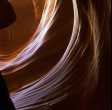 |
| antelope-section.jpg (834 x 826 - 71K) |
Let's get resolution out of the way. This is a picture of some textured sandstone in Antelope Canyon, near Page, Arizona. A great place to take photos and they do photographers tours. But leave your digital behind.
This picture here is to demonstrate the film win most people expect, namely resolution. It's really just a small crop out of the photo below.
So realize that when looking at most of the film photos. While they may be scanned to fit on the screen, in fact most have this much detail when you zoom in. There's actually more detail, but my HP Photosmart is only 2400dpi, and not that great at slides.
However, new cameras like the 11MP Canon 1ds match all but the very best film shots in resolution. However, a 5MP consumer digital doesn't.
 |
| crop0001.jpg (683 x 1024 - 41K) |
But even thos photo could not have been taken with a digital because Antelope Canyon is dark, and exposures of 30 seconds are normal. This slide was also shot on Velvia, which while slow has the finest grain and brings out colour beyond even what the eye can see.
Digital cameras simply can't shoot 30 second exposures yet, not consumer ones, as they would get too much noise. The D30, on the other hand can take long exposures, and they are clean at ISO 100. Though even it starts getting annoying noise at about 20 seconds. However it has no reciprocity failure, so that's similar to much longer on film.
 |
| (1280 x 854 - 28K) |
This shot is the sun rising through the rocks at Arches National Park. It also would suffer from bloom if shot on digital.
 |
| (683 x 1024 - 58K) |
This shot of Mount Lassen shows something I have never managed to get a good photo of with a digital camera, which is a snow-capped mountain with bright sky and dark trees. The range of contrast is just too much for 8 bits. Even this scan loses something, as it is reduced to 8 bits. The D30 with its 12 bit sensor would be able to do this shot.
 |
| (1280 x 854 - 83K) |
This striking mesa in Utah was in a space where there was no stopping on the highway. Now with some work I might have found a way to stop and photograph it, but instead this shot was taken from a moving vehicle out the window, at 1/2000th of a second. Some day digitals will shoot that fast but right now they don't. The D30 shoots to 1/4000th and does a clean ISO400. It could do this shot.
 |
| (1280 x 854 - 54K) |
This exposure of the Burning Man was shot on Fuji NHGII, which is an 800 speed film, through an f/1.8 lens. This let me handhold at night allowing the shot to see more. A digital could capture this scene but it would need a longer exposure that you might not be able to handhold. I have many other night and low like shots like this. The D30 does a clean ISO 400, and can do night shots.
 |
| (1280 x 854 - 101K) |
This picture was not taken during the day, but at night! It's Arches National Park, the Windows section, after sunset, with a tripod mounted exposure. You can see the stars in the sky. The D30 could take this shot.
 |
| arch-lightning.jpg (1280 x 852 - 61K) |
This is one of my favourite shots. Also at arches, it is a 25 second exposure, featuring twilit rocks that look like it is bright, the constellation of Sagitarius clearly in the sky, and a bright lightning bolt behind the rocks. With a digital camera, there would be no 25 second exposure, and the lightning would probably cause CCD bloom.
 |
| eclipse-sunset.jpg (1280 x 846 - 212K) |
This is the sun, setting over fog-shrouded San Francisco. That's Suttro Tower to the right. In this shot, the sun is setting while partially eclipsed by the moon. The shot is unfiltered -- raw sun in the frame along with the ability to see the waves on the water. (Even more than in this shot which I darkened for effect.) A digital camera would get tremendous bloom from the light of the raw sun. While this shot does have some flare in it, it actually has astoundingly little for a direct unfiltered picture of the sun at this angle, due to the superb Canon "L" lens. Lenses of that quality are not yet available for digital cameras. (But they are for the D30)
 |
| (900 x 600 - 57K) |
The Grand Canyon, lit by moonlight. A 30 second exposure, which was not the right exposure, so the captured range is smaller than it should be. That's one thing digitals will do nicely when they are able to capture shots like this. I expanded the range, which is why the light fall-off shows up so much. (Some digitals compensate for light fall off, a plus for them.) (This is an experiment I need to try.)
 |
| crop0011.jpg (1280 x 723 - 68K) |
A sunset in monument valley. A digital could shoot this but the tremendous saturation and contrast of Fuji Velvia brings out the red light of sunset in a way that jacking up the saturation in Photoshop doesn't seem to do.
 |
| heather-andrew-kiss.jpg (1280 x 854 - 88K) |
At a party, two friends kiss, lit by candlelight. Handheld shot with Fuji Press 800 and f/1.8 50mm lens. Colour corrected. We're seeing the limits of the film here because the light is so low, but at present I don't think many digitals could do this shot. The D30 could.
All photos Copyright 1999 Brad Templeton.